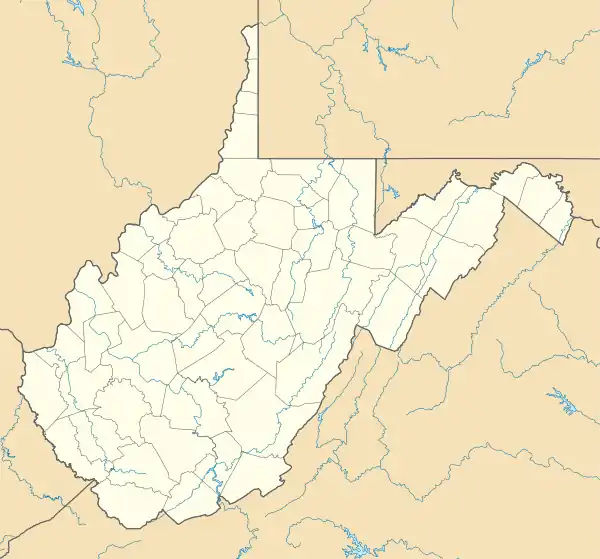Constitution of West Virginia
The Constitution of the State of West Virginia[1] is the supreme law of the U.S. State of West Virginia. It expresses the rights of the State's citizens and provides the framework for the organization of law and government. West Virginia is governed under its second and current Constitution which dates from 1872. The document includes fourteen articles and several amendments.
.png.webp)
History
The first constitution for the state was written in 1861. Following the secession of Virginia during the American Civil War, Unionist politicians established a "Restored Government" to assert their loyalty to the U.S. In November of that year, delegates from the state's westernmost counties met in convention at Wheeling to form a new state, dubbed West Virginia, and wrote a constitution for that state.[2] In the midst of the war, slavery proved to be one of the main issues at the convention, but delegates sidestepped the question of emancipation and merely prohibited enslaved persons and free persons of color from entering the state.[3] Congress, however, required the state to adopt a policy of gradual emancipation, and with that amendment made, admitted the state into the Union.[4] In 1869, the Flick Amendment created universal manhood suffrage within the state.[5]
Two years later, the state legislature called for a convention to draft a new constitution, which commenced in 1872. The convention made a number of changes to the pre-existing document, including increasing the terms of office for the governor and legislators.[6] As historian Sean Patrick Adams notes, the Flick Amendment empowered conservatives, including former Confederates, who dominated the convention. These conservatives admired the government of Virginia, and the 1872 constitution resembled the 1850 constitution of that state in many ways. County courts became the center of governmental authority, decentralizing the state, and a system of business taxation was also implemented.[7] As of 1995, this document has been amended 66 times, with an additional 46 amendments being rejected. Most amendments have been passed since 1960.[8]
Current constitution (1872)
Preamble
The preamble was added to the constitution in 1960 by referendum.[9]
Since through Divine Providence we enjoy the blessings of civil, political and religious liberty, we, the people of West Virginia, in and through the provisions of this Constitution, reaffirm our faith in and constant reliance upon God and seek diligently to promote, preserve and perpetuate good government in the State of West Virginia for the common welfare, freedom and security of ourselves and our posterity.
— Constitution of West Virginia, Preamble
Article I. Relations to the US Government
Article I defines the state in relation to the federal government. It acknowledges the supremacy of the U.S. Constitution and declares that the state constitution is set out according to the principle that powers not enumerated for the federal government are reserved to the states.[10] This article originated with the 1863 Constitution, reflecting the fact that the state was born out of the Civil War.[11]
Article II. The State

Article II sets out the state's boundaries and defines the rights of citizens. It also deals with issues such as treason, the state seal, and the wording of various legal documents.[12] Due to its origins as a split from the state of Virginia, the eastern boundary laid out in Article II was disputed by the latter state. The boundary claimed by West Virginia was eventually recognized by the U.S. Supreme Court in 1871 with the case Virginia v. West Virginia.[13]
External links
References
- "West Virginia State Constitution" (PDF). West Virginia State Legislature. Retrieved February 8, 2013. West Virginia State Constitution
- Adams 2004, pp. 214–215.
- Lewis 1889, pp. 379–380.
- Lewis 1889, pp. 391–392.
- Adams 2004, p. 235.
- Lewis 1889, pp. 450–453.
- Adams 2004, pp. 237–238.
- Bastress 2011, p. 27.
- Bastress 2011, p. 33.
- Article I of the Constitution of West Virginia (1872)
- Bastress 2011, p. 35.
- Article II of the Constitution of West Virginia (1872)
- Virginia v. West Virginia, 78 U.S. 39, 64 (1871)
Bibliography
- Adams, Sean P. (2004). Old Dominion, Industrial Commonwealth: Coal, Politics, and Economy in Antebellum America. Baltimore: Johns Hopkins University Press. ISBN 0-8018-7968-X. OCLC 54349872.
- Bastress, Robert (2011) [1995]. The West Virginia Constitution: A Reference Guide. New York: Oxford University Press. ISBN 978-0-19-977870-6 – via EBSCO.
- Lewis, Virgil Anson (1889). A History of West Virginia: In Two Parts. Philadelphia: Hubbard Brothers.
